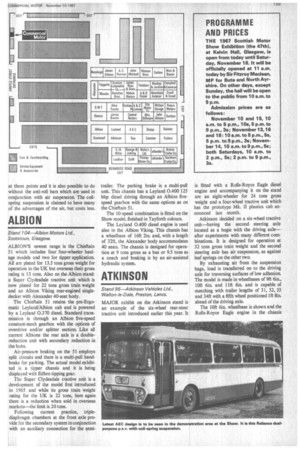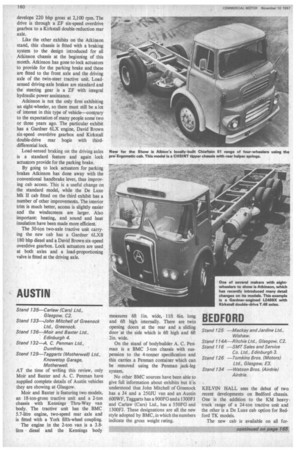Hi gher ratings,
Page 160

Page 161

Page 162

If you've noticed an error in this article please click here to report it so we can fix it.
more gears, better brakes
IN many ways the Scottish Motor Show this year is an engineers' show. But to the extent that many of the engineering changes on chassis offer really worthwhile gains in payload, in performance, safety or vehicle life, it is very much an operators' show, too.
Almost every stand has something new or modified to display, but let me just draw attention here to some of the exhibits of special interest. On the heavy goods side, three or four makes will be closely scrutinized: the big Volvos, new to this country, which to many British operators must represent an image of vehicles of the future—with gross ratings up to 70 tons; Leyland's two-pedal Beaver with splitter box giving 10 ratios, better-than-Code braking power—and BUTEC electrics, too; up-rated and newly braked Commer and Dodge haulage models (the latter moving up into the 28-ton tractive unit class); Albion's higher-weight Super Clydesdale and a 13.5-ton-gross range of workaday four-wheelers; and 24-ton KM Bedfords.
Seddon has a just-revealed 30/32-ton Rolls-Royce-engined tractive unit built with an eye on even higher weights, Scammell has the LMC 10-speed semi-automatic box in the Trunker II, while Atkinson, ERF, Bedford and Seddon have cab improvements to talk about. And biggest vehicle in the hall is Fodens' 39-ton-gross dump truck.
Brakes are a point of particular interest this year. Atkinson, Commer, Dodge, Leyland are among those with important changes on show chassis. New to British eyes are lock actuators, while spring brakes and light-laden valves, if not yet commonplace are spreading significantly.
On the p.s.v. front, two of the big attractions are AEC's coil-sprung Reliance in the demonstration area and Leyland's 33ft-long bodied Atlantean. Another long double-decker is the Western SMT Fleetline on Daimler's stand—where rubber toggle-link suspension is featured on a Roadliner.
MAIN exhibit on the AEC Stand is a Swift single-deck bus, bodied by Alexander and finished in the livery of Dundee Corporation. Appearing with it is the cut-away Mandator tractive unit which was shown for the first time at Earls Court Commercial Motor Show last year. But outside the exhibition, in the demonstration area, there is the latest design to come from AEC a Reliance bus/coach chassis with independent coil-spring suspension all round.
The Dundee Corporation Swift is one of 10 due to be delivered to this operator and the 36ft-long body has a capacity for 69 passengers, 49 seated and the rest standing. Separate air-operated entrance and exit doors make it suitable for one-man operation.
Power is provided in the Swift by an AEC AH505 horizontal diesel engine derated to give 118 bhp at 1,800 rpm and mounted at the rear. Transmission is through a semiautomatic four-speed gearbox and the airpressure braking system has independent air circuits to the front and rear axles.
The cut-away example of the Mandator is sure to be an attraction—as it was at Earls Court and at other exhibitions at which it has been featured. The Mandator chassis is designed to operate at up to 32 tons gross train weight and the AV 760 diesel engine used in it develops up to 226 bhp. Transmission is through a six-speed overdrive gearbox.
The Reliance on demonstration is one of seven for Potteries Motor Traction and this model was tested by COMMERCIAL MOTOR only a few weeks ago. The coil-spring suspension is based on the AEC air suspension which has been an alternative on the Reliance for a number of years.
Each axle has four springs which replace the air bags, and the basic air-suspension axle-location linkage is used. All linkages pivot in conical rubber-bushed joints, eliminating the need for periodic lubrication at these points and it is also possible to do without the anti-roll bars which are used in conjunction with air suspension. The coilspring suspension is claimed to have many of the advantages of the air, but costs less. trailer. The parking brake is a multi-pull unit. This chassis has a Leyland 0.400 125 bhp diesel driving through an Albion fivespeed gearbox with the same options as on the Chieftain 51.
The 10-speed combination is fitted on the Show model, finished in Tayforth colours.
The Leyland 0.400 diesel engine is used also in the Albion Viking. This chassis has a wheelbase of 1611 2in. and, with a length of 3211, the Alexander body accommodates 40 seats. The chassis is designed for operation at 9 tons gross as a bus or 9.5 tons as a coach and' braking is by an air-assisted hydraulic system. is fitted with a Rolls-Royce Eagle diesel engine and accompanying it on the stand are an eight-wheeler for 24 tons gross weight and a four-wheel tractive unit which has the prototype Mk. II plastics cab announced last month.
Atkinson decided on a six-wheel tractive unit—having the second steering axle located as a bogie with the driving axle— after experiments with many different combinations. It is designed for operation at 32 tons gross train weight and the second steering axle has air suspension, as against leaf springs on the other two. By exhausting air from the suspension bags, load is transferred on to the driving axle for traversing surfaces of low adhesion. The model is made in wheelbases of 911 6in., 10ft 6in. and 11ft 6in, and is capable of matching with trailer lengths of 31, 32, 33 and 34ft with a fifth wheel positioned 111 8in. ahead of the driving axle.
The 10ft 6in. wheelbase is shown and the Rolls-Royce Eagle engine in the chassis develops 220 bhp gross at 2,100 rpm. The drive is through a ZF six-speed overdrive gearbox to a Kirkstall double-reduction rear axle.
Like the other exhibits on the Atkinson stand, this chassis is fitted with a braking system to the design introduced for all Atkinson chassis at the beginning of this month. Atkinson has gone to lock actuators to provide for the parking brake and these are fitted to the front axle and the driving axle of the twin-steer tractive unit. Loadsensed driving-axle brakes are standard and the steering gear is a ZF with integral hydraulic power assistance.
Atkinson is not the only firm exhibiting an eight-wheeler, so there must still be a lot of interest in this type of vehicle—contrary to the expectation of many people some two or three years ago. The particular exhibit has a Gardner 6LX engine, David Brown six-speed overdrive gearbox and Kirkstall double-drive rear bogie with thirddifferential lock.
Load-sensed braking on the driving axles is a standard feature and again lock actuators provide for the parking brake.
By going to lock actuators for parking brakes Atkinson has done away with the conventional handbrake lever, thus improving cab access. This is a useful change on the standard model, while the De Luxe Mk II cab fitted on the third exhibit has a number of other improvements. The interior trim is much better, access is slightly easier and the windscreens are larger. Also important: heating, and sound and heat insulation have been made more efficient.
The 30-ton two-axle tractive unit carrying the new cab has a Gardner 6LXB 180 bhp diesel and a David Brown six-speed overdrive gearbox. Lock actuators are used at both axles and a load-proportioning valve is fitted at the driving axle.
Stand 133—John Mitchell of Greenock Ltd., Greenock Stand 136—Moir and Baxter Ltd., Edinburgh 4.
Stand 132—A. C. Penman Ltd, Dumfries.
Stand 129—Taggarts (Motherwell) Ltd, Knowe top Garage, Motherwell.
AT the time of writing this review, only Moir and Baxter and A. C. Penman have supplied complete details of Austin vehicles they are showing at Glasgow.
Moir and Baxter is featuring two models, an 18-ton-gross tractive unit and a 2-ton chassis with Kennings Thru-Way van body. The tractive unit has the BMC 5.7-litre engine, two-speed rear axle and is fitted with a York fifth-wheel coupling.
The engine in the 2-ton van is a 3.8litre • diesel and the Kennings body measures 6ft lin. wide, 11ft 6in. long and 6ft high internally. There are twin opening doors at the rear and a sliding door at the side which is 6ft high and 6ft 2in. wide.
On the stand of bodybuilder A. C. Penman is a BMC 3-ton chassis with suspension to the 4-tonner specification and this carries a Penman container which can be removed using the Penman jack-leg system.
No other BMC sources have been able to give full information about exhibits but it is understood that John Mitchell of Greenock has a J4 and a 250JU van and an Austin 600WF, Taggarts has a 900FG and a 1300FJ and Carlaw (Cars) Ltd., has a 550FG and 1300FJ. These designations are all the new style adopted by BMC, in which the numbers indicate the gross weight rating.




































































































































































































































































